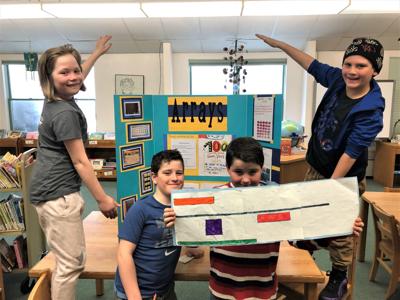KILLINGTON — First time, first place.
Killington
fourth-grade students brought home the first and second place honors in
the third- and fourth-grade division of the 3rd annual Vermont State
Math Fair at the University of Vermont, hosted by the Vermont Council of
Teachers of Mathematics.
“They were so proud of themselves,” teacher Shayna Kalnitsky said. “They’re definitely doing this again next year.”
Five
groups of students in Kalnitsky’s fourth-grade class worked on their
separate projects for weeks, making tri-fold poster boards, custom team
T-shirts and researching every aspect of their topic to be presented
before a panel of judges on April 5, among over 100 other projects and
entries, Kalnitsky said.
“We
wrote down our schedule, and we found what math we did in that day,”
said student Pippa Shaw. “Some people think math is useless and boring.”
Shaw and her two teammates, Ruby Keefe and Amelia Hurd, took on the task of proving that mathematics is useful in everyday life, such as in an afternoon at the hair salon or when Shaw is scooping out food for her family dog with a measuring cup.
Did they find they used math more often than they originally thought?
“Yeah!” All three exclaimed as they pointed to photos and graphs explaining “Amelia’s Day,” “Pippa’s Day” and “Ruby’s Day.”
“I
never knew there was going to be math in riding the bus,” Hurd said.
“You can count the seats by two ... so 52 people can ride the bus.”
“I
think the one I was really surprised about was just on my way to
school,” Keefe said. “How many minutes it takes to get there, and how
many miles there are.”
“I
use math most when I’m in the kitchen,” Shaw said. “When I’m making
eggs and toast ... there’s four people in my family, and normally I make
two eggs each, so that’s four times two is eight.”
Lillian
Smith, Adelle Danilchik and Samantha Daigle chose fractions for their
project, which ended up securing first place for their team and school.
“Me and Adelle, we nailed the presentation,” Daigle said victoriously.
The
group built their own function machine out of a cardboard box, and
focused on “Halving and Doubling” for their posterboard and
presentation. They found particular delight in the infinite times a
number can be halved without eliminating the value.
“It’s
technology,” Danilchik said as their function machine produced an
answer card. “We love halving and doubling, and we know we’ll never get
to zero.”
The group even produced an algorithm that took them from one cent to millions in one month.
“If you double a penny for 30 days, you’ll get to $5.4 million dollars,” Daigle said.
The
students included a wall of jokes and the definitions of fractions and
each of their components, as well as a historical account of
mathematical terms.
“Fraction comes from the word ‘fractio,’ which means ‘to break,’” Danilchik said.
Lillian’s
sister, Tobé Smith, along with Leland Hall and brothers William and
Christian Bisceglia presented a project on arrays, or displays of
various items in rows and columns such as a calendar or group of
candies, and how they aided in division and multiplication.
The group took their project around the school to find examples of arrays, which had to be organized in a quadrilateral form.
“(I’ll
use arrays) In my schedule,” Tobe said. “And in my counting to see — if
I’ll have kids — if they have a birthday party and they want to share
(cake) with the school.”
Ayron Romanczak and Byron Lawrence, both game lovers, chose to master probability.
Romanczak
explained that mastering probability could be helpful in a number of
scenarios, from coin-flips during football to card games, as knowing the
probability of an outcome was like predicting the future.
“I
play this game, it’s called ‘Magic the Gathering,’” Romanczak said.
“Sometimes you need to flip a coin or roll a dice, and you want to know
the probability of which side (it will fall on).”
Spencer
Claffey, Liam McKenna and Alex Winn chose “Pi” as their topic, and
wrangled second place in their age class for their presentation.
“We
were thinking of things to do that were hard,” Winn said. “Pi is an
irrational number created by the Egyptians ... but it didn’t have a name
until 1706.”
The group
researched everything from the history of pi and the timeline of its
usage from ancient Egyptian and Babylonian civilizations to today, from
Archimedes to the Welsh mathematician William Jones, who named it, they
said.
“The two letters pi come from the word ‘perimetros,’ which means perimeter in Greek,” Winn said.
“The best calculation of pi came to 31 trillion digits, which is quite a few,” Claffey added.
Kalnitsky
said the greatest victory was seeing children who had little confidence
in their math skills grow an enthusiasm for mathematics and have their
hard work rewarded with a customized medal, a constant reminder of their
personal success.
katelyn.barcellos
@rutlandherald.com
